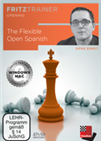Keymer keeps up the pace
One of the perks of following junior tournaments is the high degree of unpredictability. Any of the young talents might suddenly show a spark of brilliance and take down one of the leaders — and this happens more frequently than in the more stable elite events. Only one player had gone through the first two days of action unbeaten, and he was defeated in the very first round of day 3 by a player who at the time stood in shared 10th place.
 In this opening Black opts for active piece play and is not afraid to fight for the initiative from an early stage. One of the many good features of this opening is that Black is often the side which controls the pace of the game.
In this opening Black opts for active piece play and is not afraid to fight for the initiative from an early stage. One of the many good features of this opening is that Black is often the side which controls the pace of the game.
Abdusattorov was sharing the lead after eight rounds and had the black pieces against Zhu Jiner in his first game on Saturday. In the diagrammed position, Black’s pieces look rather cramped, but he does not have any weaknesses — engines actually give him a slight edge.
The way to keep that small advantage was by giving up a piece for two pawns, though, which is never an easy decision to make so early in the game. Thus, instead of going for 15...Nxe4 16.Qxe4 Qxb2, creating an imbalanced position, Abdusattorov played 15...Bc6, keeping the balance.
There followed 16.e5 dxe5 17.dxe5 Ng4 18.Nc4 Qa6 19.b3, and suddenly it is White who looks to be in the driver’s seat.
At this point, Black erred again, by lashing out with 19...b5. Zhu quickly found 20.Nd6 and got a clear positional advantage. The 18-year-old Chinese WIM never let go of her advantage and scored her third victory of the event against a player rated almost 200 points higher than her.
That single loss by Abdusattorov was critical for the standings, as his direct opponents, Awonder Liang and Vincent Keymer, had a great third day of action — both scored three wins and a draw on Saturday.
Liang’s day would have been perfect had he found the right manoeuvre in a sharp endgame against Abdusattorov in round 12.
 Smyslov cultivated a clear positional style and even in sharp tactical positions often relied more on his intuition than on concrete calculation of variations. Let our authors introduce you into the world of Vasily Smyslov.
Smyslov cultivated a clear positional style and even in sharp tactical positions often relied more on his intuition than on concrete calculation of variations. Let our authors introduce you into the world of Vasily Smyslov.
The game had been a rollercoaster, with the Uzbek GM failing to make the most of a positional advantage in the late middlegame.
By this point, however, it is Liang who has the upper hand, as 62...Bc6, defending the all-important passer on the b-file was the winning move. Surely, the American feared 63.Kc3 Na2+ 64.Kb2, as both his pieces are under attack. However, 64...Kd6 would have kept everything under control.
After 65.Rc2 Nb4, Black is fully in control and has kept his dangerous connected passers.
None of this happened, though, as Liang played 62...a3 in the first diagrammed position. The sharp struggle continued, as White kept pushing once the knights left the board and a rook vs bishop ending appeared on the board — with Black’s a-pawn still alive.
Naturally, both players were in perennial time pressure for the rest of the game. The draw was only agreed after 123 moves!
Endgame specialist Karsten Müller always keeps an eye on any instructive position that might appear on elite tournaments to share his analyses with the readers (do not miss his recent ‘Endgame Magic’ episode with Abhimanyu Mishra). Looking at the games from rounds 9 to 12, he chose another game featuring Abdusattorov, who made the most of Luke Mendonca’s mistake in a rook endgame.
 Endings with rook and minor piece against rook and minor piece occur very frequently, even more often than rook endings, yet there's not much literature on them. This endgame DVD fills this gap. The four different material constellations rook and knight vs rook and knight, rooks and opposite coloured (and same coloured ) bishops and rook and bishop vs rook and knight are dealt with. In view of the different material constellations Karsten Mueller explains many guidelines like e.g. "With knights even a small initiative weighs heavily".
Endings with rook and minor piece against rook and minor piece occur very frequently, even more often than rook endings, yet there's not much literature on them. This endgame DVD fills this gap. The four different material constellations rook and knight vs rook and knight, rooks and opposite coloured (and same coloured ) bishops and rook and bishop vs rook and knight are dealt with. In view of the different material constellations Karsten Mueller explains many guidelines like e.g. "With knights even a small initiative weighs heavily".
The immediate 42.g5 was the losing error. As GM Müller explains, White needed to play 42.Kf1 first, and only after 42...Kf6 to go for 42.g5+ Kxg5 43.Rxf7, defending. Such nuances are often decisive in masters’ games!
Standings after round 12
All games
Links























